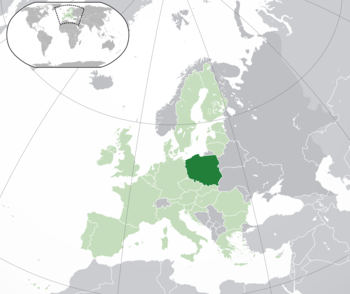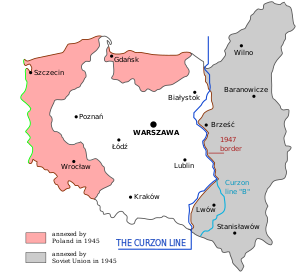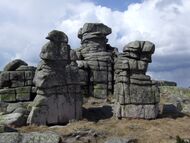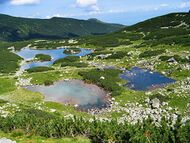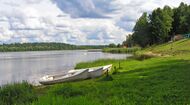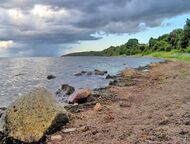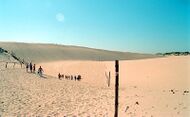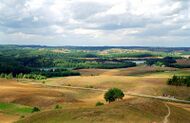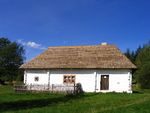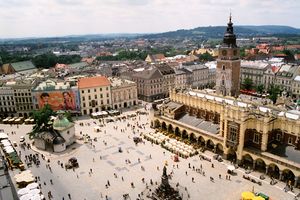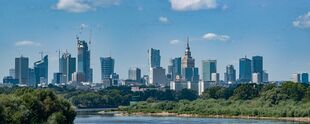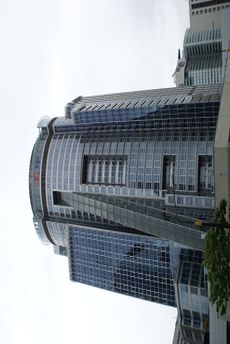بولندا
Republic of Poland Rzeczpospolita Polska (پولندية) | |
|---|---|
موقع بولندا (dark green) – on the European continent (green & dark grey) | |
| العاصمة و أكبر مدينة | Warsaw 52°13′N 21°02′E / 52.217°N 21.033°E |
| Official language | Polish[1] |
| الجماعات العرقية (2011[2]) | |
| الدين (2011[3]) |
|
| صفة المواطن | |
| الحكومة | Unitary parliamentary republic |
| Andrzej Duda | |
| Mateusz Morawiecki | |
| التشريع | Parliament |
| Senate | |
| Sejm | |
| Formation | |
| 14 April 966 | |
| 18 April 1025 | |
| 1 July 1569 | |
| 24 October 1795 | |
| 11 November 1918 | |
| 17 September 1939 | |
| 19 February 1947 | |
| 31 December 1989[5] | |
| المساحة | |
• الإجمالية | 312،696 km2 (120،733 sq mi)[6] (69th) |
• الماء (%) | 1.48 (2015)[7] |
| التعداد | |
• إحصاء 2021 | |
• الكثافة | 122/km2 (316.0/sq mi) (98th) |
| ن.م.إ. (ق.ش.م.) | تقدير 2022 |
• الإجمالي | ▲ $1.599 trillion[9] (22nd) |
• للفرد | ▲ $42,466[9] (41st) |
| ن.م.إ. (الإسمي) | تقدير 2022 |
• الإجمالي | ▲ $716.3 billion[9] (23rd) |
• للفرد | ▲ $19,023[9] (56th) |
| جيني (2020) | ▼ 27.2[10] low |
| م.ت.ب. (2021) | ▲ 0.876[11] very high · 34th |
| العملة | Złoty (PLN) |
| التوقيت | UTC+1 (CET) |
• الصيفي (التوقيت الصيفي) | UTC+2 (CEST) |
| صيغة التاريخ | dd.mm.yyyy (CE) |
| جانب السواقة | right |
| مفتاح الهاتف | +48 |
| النطاق العلوي للإنترنت | .pl |
پولندا (بالبولندية: Polska) هي جمهورية تقع في شرق أوروبا. يحدها من الشمال بحر البلطيق، من الشمال الشرقي إقليم كالينينگراد الروسي وليتوانيا، من الشرق روسيا البيضاء وأوكرانيا، من الجنوب سلوفاكيا وتشيكيا، من الغرب ألمانيا. ما يُميز پولندا عن جاراتها هو أن 90% من شعبها يتبعون الكنيسة الكاثوليكية، وهذا غير معهود في دول شرق أوروبا التي يدين معظم سكانها بالأرثودكسية.
Poland has a temperate transitional climate and its territory traverses the Central European Plain, extending from Baltic Sea in the north to Sudeten and Carpathian Mountains in the south. The longest Polish river is the Vistula, and Poland's highest point is Mount Rysy, situated in the Tatra mountain range of the Carpathians. The country is bordered by Lithuania and Russia to the northeast,[ب] Belarus and Ukraine to the east, Slovakia and the Czech Republic to the south, and Germany to the west. It also shares maritime boundaries with Denmark and Sweden.
The history of human activity on Polish soil dates to circa 10,000 BC. Culturally diverse throughout late antiquity, the region became inhabited by tribal Polans who gave Poland its name in the early medieval period. The establishment of statehood in 966 coincided with a pagan ruler of the Polans converting to Christianity under the auspices of the Roman Church. The Kingdom of Poland emerged in 1025 and in 1569 cemented its longstanding association with Lithuania, thus forming the Polish–Lithuanian Commonwealth. It was one of the largest great powers of Europe at the time, with a uniquely liberal political system that adopted Europe's first modern constitution in 1791.
With the passing of a prosperous Polish Golden Age, the country was partitioned by neighbouring states at the end of the 18th century and regained its independence in 1918 as the Second Polish Republic. In September 1939, the German-Soviet invasion of Poland marked the beginning of World War II, which resulted in the Holocaust and millions of Polish casualties. As a member of the Communist Bloc in the global Cold War, the Polish People's Republic was a founding signatory of the Warsaw Pact. Through the emergence and contributions of the Solidarity movement, the communist government was dissolved and Poland re-established itself as a democratic state in 1989.
Poland is a parliamentary republic, with its bicameral legislature comprising the Sejm and the Senate. It is a developed market and a middle power; it has the sixth largest economy in the European Union by GDP (nominal) and the fifth largest by GDP (PPP). It provides very high standards of living, safety and economic freedom, as well as free university education and a universal health care system. The country has 17 UNESCO World Heritage Sites, 15 of which are cultural. Poland is a founding member state of the United Nations, as well as a member of the World Trade Organization, NATO, and the European Union (including the Schengen Area).
أصل الاسم
The native Polish name for Poland is Polska.[12] The name is derived from the Polans, a West Slavic tribe who inhabited the Warta River basin of present-day Greater Poland region (6th–8th century CE).[13] The tribe's name stems from the Proto-Slavic noun pole meaning field, which in-itself originates from the Proto-Indo-European word *pleh₂- indicating flatland.[14] The etymology alludes to the topography of the region and the flat landscape of Greater Poland.[15][16] The English name Poland was formed in the 1560s, from German Pole(n) and the suffix -land, denoting a people or nation.[17][18] Prior to its adoption, the Latin form Polonia was widely used throughout medieval Europe.[19]
The country's alternative archaic name is Lechia and its root syllable remains in official use in several languages, notably Hungarian, Lithuanian, and Persian.[20] The exonym possibly derives from either Lech, a legendary ruler of the Lechites, or from the Lendians, a West Slavic tribe that dwelled on the south-easternmost edge of present-day Lesser Poland region.[21][22] The origin of the tribe's name lies in the Old Polish word lęda (plain).[23] Initially, both names Lechia and Polonia were used interchangeably when referring to Poland by chroniclers during the Middle Ages.[24]
التاريخ
نُصب كروبري (Chrobry) كأول ملك بولندي للبلاد عام 1025. ضُمت أجزاء كبيرة من البلاد إلى الامبراطورية الرومانية المقدسة عام 1163. بعد إعادة توحيد البلاد تدريجياً في القرن الخامس عشر، أُعلن قيام الوحدة عام 1447 مع ليتوانيا. قُسمت بولندا ثلاث مرات في الأعوام 1772، 1793 و 1795. بعد هزيمة نابليون، اتفقت الدول المنتصرة: النمسا،بروسيا و روسيا على تقسيم بولندا نهائياً فيما بينهم عام 1815. هكذا أضحى البولنديون شعب بلا دولة حتى إعلان قيام مملكة بولندا مجدداً عام 1916 في خضم أحداث الحرب العالمية الأولى 1914 - 1919. أُعلنت الجمهورية عام 1918 وضمت في السنوات اللاحقة أراضي بولندية سابقة للدولة. في فترة ما بين الحربين العالميتين 1919 - 1939، عاشت بولندا حالة من عدم الاستقرار السياسي والاقتصادي، ساعد ضعفها في السيطرة على الأوضاع في مواجهة التهدبد السوفيتي و الألماني المستمر على ذلك. اتفاق عدم الاعتداء بين هتلر وستالين عام 1939، قسم الأراضي الواقعة بين بلديهما و من ضمنها بولندا. هكذا أشعلت ألمانيا فتيل الحرب العالمية الثانية بغزوها لبولندا في 1 سبتمبر 1939، كذلك تقدمت القوات السوفيتية من جهة الشرق و أصبحت بولندا خلال أيام معدودة غير موجودة على الخريطة.
لكن سرعان ما أعلنت ألمانيا الحرب على الاتحاد السوفياتي عام 1941 واستولت لاحقاً على شرق بولندا أيضاً. تمكنت القوات السوفيتية من هزيمة القوات الألمانية و بسط السيطرة السوفيتية على بولندا مجدداً عام 1945. بدأ السوفيات ببناء الدولة البولندية الجديدة على الطريقة السوفياتية الشيوعية. كانت بولندا من الآن فصاعداً جزء من الكتلة الشرقية ففي عام 1952 أُعلنت بولندا كجمهورية شعبية بدستور جديد و في عام 1955 أُسس حلف وارسو. بدأت الحركة الديمقراطية بالصعود في بداية الثمانينات إلى أن تمكنت عام 1989 من تشكيل أول حكومة بدون أن يكون رئيسها شيوعي. لخ ڤاونسا (Wałęsa) أصبح عام 1990 أول رئيس للبلاد منتخب. أعلنت بولندا، هنغاريا و تشيكوسلوفاكيا عام 1991 رغبتهم في الانضمام للغرب. أصبحت بولندا في نفس العام عضو بالمجلس الاوروبي، عام 1999 بحلف شمال الأطلسي (الناتو) و عام 2004 بالاتحاد الاوروبي.
ما قبل التاريخ
Piast dynasty

Jagiellon dynasty
الكومنولث البولندي الليتواني
تقسيم بولندا
اعادة تشكيل بولندا
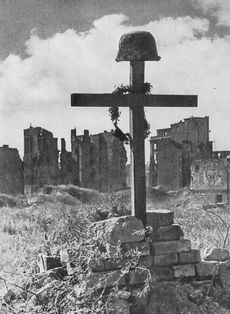
الحرب العالمية الثانية
ما بعد الحرب الشيوعية

"The 4th of June, 1989 marked a decisive victory for democracy in Poland and, ultimately, across Eastern Europe."
بولندا في العصر الحالي
الجغرافيا
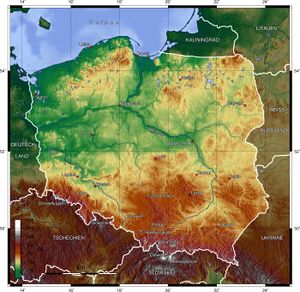
أراضي پولندا تكون منطقة طبيعية انتقالية بين المناطق المنخفضة في شرق أوروبا و المناطق المنخفضة في شمال ألمانيا. طبيعة البلاد في الشمال سهلية بينما تزداد المرتفعات كلما اتجهنا جنوباً. تشكل سلسلتي جبال السوديت و كارباتي حدود بولندا الطبيعية مع جمهورية التشيك وسلوفاكيا. أعلى جبل هو جبل ريسي (Rysy) بارتفاع 2499 متر. نهر فيسوا هو أطول نهر، نهر أودرا (أودر) يكون الحدود الطبيعية مع ألمانيا. تغطي الغابات 28% من مساحة البلاد. المناخ بشكل عام معتدل، ويصبح قارياً كلما اتجهنا شرقاً و خاصة جنوب شرق. تقع بولندا وسط قارة أوروبا، ويحدها بحر البلطيق من الشمال، وتشيكوسلوفاكيا من الجنوب، واوكرانيا من الشرق والشمال الشرقي، وألمانيا من الغرب، نبلغ مساحتها 312,683 كيلو متراً مربعاً، وعدد سكانها في سنة (1408 هـ- 1988 م ) ، (37,860,000 ) نسمة، وأهم المدن كراكوف، وبوزنان، ومن موانئها علي بحر البلطيق شتشاتشيتن وجدانسك (دانزيج ) وعاصمتها وارسو (فارشافا)، وعدد سكانها حوالي مليونين، وتنقسم البلاد إدارياً إلى (17 ) قسماً.
تضم أرضها ثلاثة أقسام، سهول في الشمال، وتطل على بحر البلطيق بطول يصل إلى 500 كيلومتر، وتشرف على مجموعة من البحيرات الساحلية، وتمتد السهول من مصب نهر أودر إلى خليج دانريج والقسم الساحلي من هذه السهول قليل الخصوبة تتخلله الكتبان الرملية، أما القسم الجنوبي من السهول فأكثر خصوبة نسبياً، وإن كانت تربتها تتكون من الركامات الجليدية، والقسم الثاني من أرض بولندا هضبة قليلة الارتفاع مستوية السطح أثرت فيها التعرية الجليدية، ويليها القسم الثالث وهو المضرس من أرضها حيث القسم الشمالي من سفوح الكربات الغربية (الفودلاند ).
نهر ڤستولا في مودلن
Kurtkowiec, oligotrophic lake في جنوب شرق پولندا
بحيرة في Gołdap
Hala Gąsienicowa في تاترا العالية
Bay of Puck (Zatoka Pucka) في پولندا
كثبان في Słowiński National Park
The patchwork landscape of ماسوريا
المناخ
ينتمي مناخ بولندا إلى النمط القاري البارد، وهذه السمة تأتي من موقعها المتطرف، وبعدها عن المؤثرات الأطلنطية، فالشتاء بارد وتنخفض الحرارة في معظم مناطقها إلى ما دون الصفر، ويتساقط الثلج في معظم أيام الشتاء ، ويثأثر المناخ بالرياح الباردة القادمة من الشمال، والصيف دافيء، والتساقط المطري معظمه صيفي، والمرتغعات الجنوبية أوفر مطراً من السهول في الشمال.
مناخ بولندا هو انتقالي معتدل، ويتفاوت من محيطي في الشمال الغربي إلى قاري في الجنوب الشرقي.[26] الأطراف الجنوبية الجبلية تقع ضمن مناخ الألپ.[26] تتميز پولندا بصيف دافئ، بمتوسط درجة حرارة 20 °س في يوليو، وشتاء بارد باعتدال بمتوسط -1 °س في ديسمبر.[27] الجزء الأدفا والأكثر تعرضاً للشمس في بولندا هو سيليزيا السفلى في الجنوب الغربي وأبرد منطقة هي الركن الشمالي الشرقي، حول سوڤاوكي في Podlaskie province, حيث يتأثر المناخ بالجبهات الباردة من اسكاندناڤيا و سيبيريا.[28] يكثر هطول الأمطار في أشهر الصيف، حيث يُسجل أعلى سقوط أمطار من يونيو إلى سبتمبر.[27]
There is a considerable fluctuation in day-to-day weather and the arrival of a particular season can differ each year.[26] Climate change and other factors have further contributed to interannual thermal anomalies and increased temperatures; the average annual air temperature between 2011 and 2020 was 9.33 °C (48.8 °F), around 1.11 °C higher than in the 2001–2010 period.[28] Winters are also becoming increasingly drier, with less sleet and snowfall.[26]
التنوع الحيوي

Phytogeographically, Poland belongs to the Central European province of the Circumboreal Region within the Boreal Kingdom. The country has four Palearctic ecoregions – Central, Northern, Western European temperate broadleaf and mixed forest, and the Carpathian montane conifer. Forests occupy 31% of Poland's land area, the largest of which is the Lower Silesian Wilderness.[29] The most common deciduous trees found across the country are oak, maple, and beech; the most common conifers are pine, spruce, and fir.[30] An estimated 69% of all forests are coniferous.[31]
The flora and fauna in Poland is that of Continental Europe, with the wisent, white stork and white-tailed eagle designated as national animals, and the red common poppy being the unofficial floral emblem.[32] Among the most protected species is the European bison, Europe's heaviest land animal, as well as the Eurasian beaver, the lynx, the gray wolf and the Tatra chamois.[33] The region was also home to the extinct aurochs, the last individual dying in Poland in 1627.[34] Game animals such as red deer, roe deer, and wild boar are found in most woodlands.[35] Poland is also a significant breeding ground for migratory birds and hosts around one quarter of the global population of white storks.[36]
Around 315،100 هكتار (1،217 sq mi), equivalent to 1% of Poland's territory, is protected within 23 Polish national parks, two of which – Białowieża and Bieszczady – are UNESCO World Heritage Sites.[37] There are 123 areas designated as landscape parks, along with numerous nature reserves and other protected areas under the Natura 2000 network.[38]
الحكومة
النظام السياسي
أصبحت بولندا بعد إنتهاء الحقبة الشيوعية دولة ديمقراطية برلمانية. البرلمان البولندي (Zgromadzenie Narodowe) مكون من مجلسين اثنين: مجلس الأعيان (Senat) و به 100 عضو و مجلس النواب (Sejm) و به 460 عضو. رئيس الحكومة هو رئيس الوزراء اللذي يعين من رئيس الدولة اعتماداً على نتائج الانتخابات النيابية. أهم الأحزاب البولندية:
- تحالف اليسار الديمقراطي (SLD): يساري
- حزب الحرية (UW): ليبرالي وسط
- جبهة المواطنين (PO): وسط
- اتحاد العمل (UP): يساري
- حزب العمال البولندي المتحد (PZPR): يساري (شيوعي سابق)و هو منحل و وريثه حزب تحالف اليسار الديموقراطي (SLD)
الى جانب عدة أحزاب يمينية صغيرة.
السياسة الخارجية
كانت بولندا تتبع الاتحاد السوفياتي فيما يتعلق بالسياسة الدولية بين 1945 - 1990. كان هناك برنامج تعاوني اقتصادي مكثف يُعرف بإسم الكوميكون بين دول الكتلة الشيوعية من ضمنها بولندا. استمر تطبيع العلاقات بين ألمانيا و بولندا عقود عدة بعد الحرب، إلى أن وُقعت أخيراً عام 1990 اتفاقية ترسيم الحدود بين البلدين، اعترفت بموجبها ألمانيا بحدود بولندا اللتي كانت دائماً موضع خلاف بين البلدين. قامت بولندا عام 1972 بإنشاء علاقات دبلوماسية مع ألمانيا الغربية. بعد انهيار الاتحاد السوفياتي و سقوط الحكم الشيوعي في بولندا، أصبحت البلاد تتبع سياسة موالية للغرب و داعية للانضمام إلى المنظمات و الاتفاقيات الدولية و الاوروبية. البلد اللتي كانت يوماً ما تحتضن حلف وارسو أصبحت عام 1999 نفسها عضو بحلف شمال الأطلسي (الناتو). يرى الاتحاد الاوروبي في بولندا بلداً واعداُ و خاصة في مجال الزراعة، اللذي قد يجيء بالخيرات على الاتحاد، علماً بأنها الأكبر من حيث المساحة و السكان بين الدول العشر المنضمة عام 2004 للاتحاد، اللتي من ضمنهم بولندا.
التقسيمات الادارية
منذ إعادة التقسيم الاداري عام 1999 و البلاد مقسمة إلى 16 مقاطعة (województwo). كل منها له برلمانها الخاص و حكومتها و رئيسين واحد معين (Wojewoda) من الحكومة المركزية وواحد منتخب (Marszałek) من البرلمان. المقاطعات البولندية هي:
|
|
|
|
أكبر المدن هي العاصمة وارسو (1,689,600 نسمة/عام 2003) تليها: لودز (777,500 نسمة/عام 2003)، كراكاو (750,000 نسمة/عام 2003)، فروتسلاو (638,401 نسمة/عام 2003)، بروزنان (578,900 نسمة/عام 2002)، غدانسك (461,400 نسمة/عام 2003) و ستيتين (413,000 نسمة/عام 2004).... جيراردوف (40,000 نسمة/عام 2000).
| ||||||||||||||||||||||||||||||||||||||||||||||||||||||
العسكرية
الديموغرافيا
Poland, with 38,116,000 inhabitants,[39] has the eighth-largest population in Europe and the sixth-largest in the European Union. It has a population density of 122 inhabitants per square kilometer (328 per square mile).

يبلغ عدد سكان بولندا حوالي 40 مليون نسمة. البولنديون يشكلون الغالبية العظمى بينما هناك أقليات غجرألمانية، أوكرانية، روسية بيضاء و غيره. بين الجاليات الأجنبية المقيمة في البلاد يكون الفيتناميون الأغلبية ، يتلوهم اليونان و المقدونيين. لقد خضع سكان بولندا إلى العديد من عمليات النقل الجماعي في أثناء سيطرة القوي المختلفة من جيرانها ، وعدد سكانها (37,860,00 ) نسمة ، وهم أكثر شعوب وسط أوروبا نمواً ، ويتكون السكان من البولندين وهم الغالبية العظمي من السكان ، ثم أقليات ألمانية وروسية ، ولقد قتل وشرد منهم عدة ملايين في الحرب العالمية الثانية ، وترتفع الكثافة السكانية في الجنوب وتقل في الشمال ، وبدأ سكان المدن بالتزايد نتيجة الصناعة ،وبولندا الدولة الشيوعية الوحيدة التي تعترف بالتعليم الديني ، فغالبية سكانها من الكاثوليك ، وهذا عامل من عوامل مقاومة النفوذ الشيوعي الذي سقط أخيراً .
المناطق الحضرية
الديانة
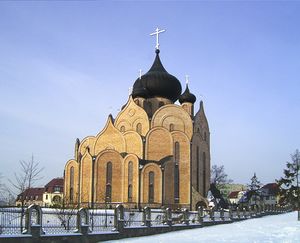
حوالي 90% من البولنديين هم كاثوليك، منهم حوالي الثلثين من الممارسين للدين و الباقي فقط اسمياً. هناك أيضاً أقليات أورثوذكسية، بروتستانتينية، مسلمة و يهودية. تنصيب كاردينال كنيسة كراكوف كارول فويتيلا ليصبح بابا الفاتيكان يوحنا بولس الثاني عام 1978 دعم الصحوة الدينية في البلاد و خاصة إبان الحكم الشيوعي.
الاقتصاد والسياحة
Economic indicators
| ||
|---|---|---|
| GDP (PPP) | $1.599 trillion (2022) | [9] |
| Nominal GDP | $716 billion (2022) | [9] |
| Real GDP growth | 4.5% (2019) | [40] |
| CPI inflation | 2.2% (2019) | [41] |
| Employment-to-population ratio | 55% (2019) | [42] |
| Unemployment | 2.9% (2021) | [43] |
| Total public debt | $274 billion (2019) | [44] |



اقتصاد بولندا صناعي زراعي و تساهم الصناعة بنصف الدخل القومي ، وأهم الصناعات تتمثل في بناء السفن والسيارات والآلات الكيميائية وتكرير البترول والزجاج والمنسوجات، اما الزراعة فيعمل بها حوالي 32% من سكان بولندا وتشغل نصف مساحة البلاد، ومسموح في بولندا بالملكية الفردية، ويملك المزارعون 87% من الأراضي الزراعية، وتنتج 84% من الإنتاج الزراعي ،وأهم الحاصلات القمح والشعير. هذا إلى جانب الشوفان والجودار، وهو المحصول الأول، والبنجر السكري ،والبطاطس والخضر ،وتغطي الغابات ربع مساحة بولندا ،وكانت تصدر كميات كبيرة من المنتجات الخشبية وقلت الآن عن ذي قبل، وتوجد أفضل المراعي في جنوب بولندا، والثروة الحيوانية عنصر هام في اقتصادها، ومعظم ثروتها الحيوانية من الابقار والخنازير.
تحول اقتصاد بولندا إلى اقتصاد السوق مع إنهيار الحكم الشيوعي. توج هذا التحول في عام 2004 بانضمام البلاد إلى الاتحاد الأوروبي. تستخدم حوالي 60% من مساحة بولندا للزراعة لذا أضحى القطاع الزراعي أهم أعمدة الاقتصاد، اللذي ينقصه الاستثمارات و الاصلاح. أهم المنتجات الزراعية هي الحبوب، البطاطس، الشمندر السكري، الخضروات و الفاكهة. من المتوقع أن تصبح بولندا أهم منتج زراعي في الاتحاد الأوروبي خلال الأعوام القادمة. تملك البلاد ثروة حيوانية ضخمة. الفحم بأنواعه، الخارصين و الرصاص هي أهم المعادن المتواجدة في بولندا. أهم الصناعات هي الآلية، بناء السفن، تكرير النفط، الورق، المنسوجات، الكيميائية و الالكترونية. المدن و الطبيعة البولندية تجذب مئات الآلاف من السياح سنوياً.
تعد بولندا بلداً مهماً فيما يتعلق بالتجارة و النقل بين شرق و غرب أوروبا، و بين البلقان و شمال أوروبا. شركة القطارات البولندية (Polskie Koleje Państwowe) تدير معظم شبكات السكك الحديدية في البلاد. هناك شبكة طرق برية كبيرة و لكن ينقصها الطرق السريعة. أهم الموانئ البحرية هي غدانسك، ستيتين، غدينيا. شركة لوت (LOT) هي شركة الخطوط الجوية الوطنية.
التعليم، العلوم والتقنية
الثقافة البولندية ثقافة متنوعة مرتبطة بالتغير اللذي صاحب تاريخ البلاد. حاولت الصمود أمام تأثير الدول المجاورة و المحتلة لبولندا كألمانيا مثلاً. أهم الشخصيات الثقافية البولندية: الشاعر أدم ميكيفز ( Mickiewicz)، الرسام جان ماتيكو (Matejko) و الموسيقار فريدريك شوبان (Chopin).
التعليم المدرسي يبدأ من سن السادسة أو السابعة في المدرسة الابتدائية (Szkoła podstawowa) و ينتهي في المدرسة الثانوية (Liceum)، مروراً بالمدرسة الإعدادية (Gimnazjum). هناك عدة شهادات جامعية أهمها البكالوريوس (licencjat) و لاحقاً الماستر (magister) و الدكتوراة (doktor).
التعليم والعلوم
البحث والتنمية

الاتصالات
الثقافة
اللغة
اللغة الرسمية هي اللغة البولندية، اللتي تتبع اللغات السلافية.
الأعياد والعطل
العطل الرسمية هي رأس السنة الميلادية (الأول من كانون الثاني/يناير)، عيد الفصح، عيد العمال (1 أيار/مايو)، يوم الدستور (3 أيار/مايو)، عيد العنصرة (سابع خميس بعد عيد الفصح)، عيد القربان (تاسع خميس بعد عيد الفصح)، عيد الصعود (15 آب/اغسطس)، عيد جميع القديسين (الأول من تشرين الثاني/نوفمبر) و ليلة و عيد الميلاد المجيد (25-26 كانون الأول/ديسمبر) و عيد الاستقلال 11 تشرين الثاني/نوفمبر.
مشاهير


الموسيقى
Polonaise & Mazurka The mazurka is a stylized Polish folk dance in triple meter with a lively tempo that has a heavy accent on the third or second beat. Its folk origins are the slow kujawiak and the fast oberek. |
المطبخ

الزراعة

الرياضة
ترتيبات دولية
The following are links to international rankings of Poland.
| المؤشر | الترتيب | البلدان |
|---|---|---|
| مؤشر التنمية البضرية 2007 | 37th | 177 |
| OECD Working time | 2nd | 27 |
| مؤشر الحرية الاقتصادية 2008 | 83rd | 157 |
| Privacy International Yearly Privacy ranking of countries, 2007 | 19th | 45 |
| Rمراقبون بلاد حدود، مؤشر مراقبة الصحافة 2009 | 37th | 175 |
| UNICEF Child Well-being league table | 14th | 21 |
| Networked Readiness Index 2009–2010 | 65th | 133 |
| OICA Automobile Production | 18th | 53 |
انظر أيضا
ملاحظات
- ^ Many declared more than one ethnic or national identity. The percentages of ethnic Poles and minorities depend on how they are counted. 94.83% declared exclusively Polish identity, 96.88% declared Polish as their first identity and 97.10% as either first or second identity. Around 98% declared some sort of Polish as their first identity.
- ^ The adoption of Christianity in Poland is seen by many Poles, regardless of their religious affiliation or lack thereof, as one of the most significant events in their country's history, as it was used to unify the Polish tribes.[4]
- ^ Poland borders the Kaliningrad Oblast, an exclave of Russia.
المصادر والهوامش
- الأقليات المسلمة في أوروبا – سيد عبد المجيد بكر
- ^ Constitution of the Republic of Poland, Article 27.
- ^ Struktura narodowo-etniczna, językowa i wyznaniowa ludności Polski. Narodowy Spis Powszechny Ludności i Mieszkań 2011 [National-ethnic, linguistic and religious structure of Poland. National Census of Population and Housing 2011] (PDF) (in البولندية). Central Statistical Office. 2015. p. 36. ISBN 978-83-7027-597-6.
- ^ Struktura narodowo-etniczna, językowa i wyznaniowa ludności Polski. Narodowy Spis Powszechny Ludności i Mieszkań 2011 [National-ethnic, linguistic and religious structure of Poland. National Census of Population and Housing 2011] (PDF) (in البولندية). Central Statistical Office. 2015. p. 93. ISBN 978-83-7027-597-6.
- ^ Christian Smith (1996). Disruptive Religion: The Force of Faith in Social-movement Activism. Psychology Press. ISBN 978-0-415-91405-5. Retrieved 9 September 2013 – via Google Books.
- ^ "The Act of December 29, 1989 amending the Constitution of the Polish People's Republic". Internetowy System Aktów Prawnych. Retrieved 18 October 2020. (in پولندية)
- ^ GUS. "Powierzchnia i ludność w przekroju terytorialnym w 2018 roku".
- ^ "Surface water and surface water change". Organisation for Economic Co-operation and Development (OECD). Retrieved 11 October 2020.
- ^ "Informacja o wynikach Narodowego Spisu Powszechnego Ludności i Mieszkań 2021". Retrieved 20 November 2022.
- ^ أ ب ت ث ج ح "World Economic Outlook Database, October 2022". IMF.org. International Monetary Fund. October 2022. Retrieved October 11, 2022.
- ^ "Gini coefficient of equivalised disposable income". Eurostat. Archived from the original on 9 October 2020. Retrieved 21 June 2022.
- ^ Nations, United (8 September 2022). "Human Development Report 2021/2022" (PDF) (in الإنجليزية). United Nations Development Programme. Retrieved 11 September 2022.
- ^ Thompson, Wayne C. (2021). Nordic, Central, and Southeastern Europe 2020-2022. Blue Ridge Summit: Rowman & Littlefield Publishers. p. 322. ISBN 9781475856262.
- ^ Lukowski, Jerzy; Zawadzki, Hubert (2001). A Concise History of Poland. Cambridge: Cambridge University Press. p. 4. ISBN 0521551099.
- ^ Lehr-Spławiński, Tadeusz (1978). Język polski. Pochodzenie, powstanie, rozwój (in Polish). Warszawa (Warsaw): Państwowe Wydawnictwo Naukowe. p. 64. OCLC 4307116.
{{cite book}}: CS1 maint: unrecognized language (link) - ^ Potkański, Karol (2004) [1922]. Pisma pośmiertne. Granice plemienia Polan (in Polish). Vol. 1 & 2. Kraków: Polska Akademia Umiejętności. p. 423. ISBN 9788370634117.
{{cite book}}: CS1 maint: unrecognized language (link) - ^ Everett-Heath, John (2019). "Poland (Polska)". The Concise Dictionary of World Place-Names. Oxford: University Press. ISBN 9780191905636.
- ^ Harper, Douglas (n.d.). "Poland (n.)". Online Etymology Dictionary. Retrieved 1 August 2021.
- ^ Harper, Douglas (n.d.). "Pole (n.)". Online Etymology Dictionary. Retrieved 1 August 2021.
- ^ Buko, Andrzej (2014). Bodzia. A Late Viking-Age Elite Cemetery in Central Poland. Leiden: Brill. pp. 36, 62. ISBN 9789004281325.
- ^ Hannan, Kevin (1994). Language and Identity in a West Slavic Borderland: The Case of Teschen Silesia. Austin: University of Texas. p. 127. OCLC 35825118.
- ^ Dabrowski, Patrice M. (2014). Poland. The First Thousand Years. New York: Cornell University Press. ISBN 9781501757402.
- ^ Kamusella, Tomasz (2022). Words in Space and Time: A Historical Atlas of Language Politics in Modern Central Europe. Budapest: Central European University Press. p. 9. ISBN 9789633864180.
- ^ Małecki, Antoni (1907). Lechici w świetle historycznej krytyki (in Polish). Lwów (Lviv): Zakład Narodowy im. Ossolińskich. p. 37. ISBN 9788365746641.
{{cite book}}: CS1 maint: unrecognized language (link) - ^ Andersson, Theodore Murdock; Morkinskinna, Ellen Gade (2000). The Earliest Icelandic Chronicle of the Norwegian Kings (1030-1157). Ithaca: Cornell University Press. p. 471. ISBN 9780801436949.
- ^ (إنگليزية) "Merkel honours Polish freedom struggle and Tiananmen victims". www.thelocal.de. AFP. Retrieved 2009-09-28.
- ^ أ ب ت ث Korzeniewska, Ewa; Harnisz, Monika (2020). Polish River Basins and Lakes. Vol. I: Hydrology and Hydrochemistry. Cham: Springer International Publishing. pp. 4–5. ISBN 9783030121235.
- ^ أ ب Azad, Abdul Kalam; Khan, Mohammad Masud Kamal (2021). Bioenergy Resources and Technologies. London: Elsevier. p. 6. ISBN 9780128225264.
- ^ أ ب Zbigniew Ustrunul; Agnieszka Wypych; Ewa Jakusik; Dawid Biernacik; Danuta Czekierda; Anna Chodubska (2020). Climate of Poland. Institute of Meteorology and Water Management - National Research Institute (IMGW). p. 7. Archived from the original. You must specify the date the archive was made using the
|archivedate=parameter. https://www.imgw.pl/sites/default/files/2021-04/imgw-pib-klimat-polski-2020-opracowanie-final-eng-rozkladowki-min.pdf. Retrieved on 3 April 2022. - ^ "Forest area (% of land area) - Poland". World Bank. Retrieved 1 April 2021.
- ^ Milewski, Wawrzyniec (2017). Forests in Poland 2017 (PDF). Warsaw (Warszawa): State Forests Information Centre. p. 8. ISBN 9788365659231.
- ^ Frouz, Jan; Frouzova, Jaroslava (2022). Applied Ecology: How agriculture, forestry and fisheries shape our planet. Cham: Springer International Publishing. p. 245. ISBN 9783030832254.
- ^ Aniskiewicz, Alena (2016). "That's Polish: Exploring the History of Poland's National Emblems". culture.pl. Adam Mickiewicz Institute. Retrieved 3 April 2022.
"A white eagle [...], the profile of a shaggy bison in a field of grass. These are emblems of Poland". "Nation's (somewhat disputed) national flower – the corn poppy".
- ^ خطأ استشهاد: وسم
<ref>غير صحيح؛ لا نص تم توفيره للمراجع المسماةRocznik - ^ Rokosz, M. (1995). "History of the Aurochs (Bos taurus primigenius) in Poland" (PDF). Animal Genetics Resources Information. 16: 5–12. doi:10.1017/S1014233900004582. Archived from the original (PDF) on 14 January 2013.
- ^ Reidar Andersen; Marco Apollonio; Rory Putman; Piotr Wawrzyniak (2010). European Ungulates and Their Management in the 21st Century. Cambridge: University Press. pp. 223–231. ISBN 9780521760614.
- ^ Kevin Hillstrom; Laurie Collier Hillstrom (2003). Europe: A Continental Overview of Environmental Issues, Volume 4. ABC-CLIO World geography. p. 34. ISBN 978-1-57607-686-6.
- ^ Mayer, Marius (2019). Cross-Border Tourism in Protected Areas: Potentials, Pitfalls and Perspectives. Cham: Springer. p. 115. ISBN 9783030059606.
- ^ Kowalczyk, Barbara; Mikowski, Rafał; Mikowski, Łukasz (2019). Environmental law in Poland. Alphen aan den Rijn: Kluwer Law International. ISBN 9789403509501.
- ^ خطأ استشهاد: وسم
<ref>غير صحيح؛ لا نص تم توفيره للمراجع المسماةCSO_2008 - ^ "GDP growth (annual %) – Poland | Data". data.worldbank.org.
- ^ "Inflation, consumer prices (annual %) – Poland | Data". data.worldbank.org.
- ^ "Employment to population ratio, 15+, total (%) (modeled ILO estimate) – Poland | Data". data.worldbank.org.
- ^ "Eurostat: Poland in second place with the lowest unemployment in the European Union". www.gov.pl.
- ^ "Poland National Debt 2020". countryeconomy.com.
وصلات خارجية
![]() تعريفات قاموسية في ويكاموس
تعريفات قاموسية في ويكاموس
![]() كتب من معرفة الكتب
كتب من معرفة الكتب
![]() اقتباسات من معرفة الاقتباس
اقتباسات من معرفة الاقتباس
![]() نصوص مصدرية من معرفة المصادر
نصوص مصدرية من معرفة المصادر
![]() صور و ملفات صوتية من كومونز
صور و ملفات صوتية من كومونز
![]() أخبار من معرفة الأخبار.
أخبار من معرفة الأخبار.
- عامة
- Polish Information
- Ministry of Foreign Affairs
- Poland at UCB Libraries GovPubs
- History of Ancient Poland
- بولندا at the Open Directory Project
 Wikimedia Atlas of Poland
Wikimedia Atlas of Poland
- الثقافة
- السفر
- CS1 البولندية-language sources (pl)
- Articles with پولندية-language sources (pl)
- Short description is different from Wikidata
- Articles containing پولندية-language text
- Pages using gadget WikiMiniAtlas
- Articles with hatnote templates targeting a nonexistent page
- Articles containing ألمانية-language text
- Pages using image label with a wide image
- Pages using image label with a tall image
- Pages using Lang-xx templates
- Articles containing إيطالية-language text
- Pages with empty portal template
- پولندا
- بلدان أوروپا
- أعضاء الاتحاد الأوروپي
- بلدان سلافية
- وسط أوروپا
- Countries bordering the Baltic Sea
- جمهوريات
- ديمقراطيات ليبرالية
- دول وأراضي تأسست في 1918
- دول عضو اتحاد البحر المتوسط
- Members of the North Atlantic Treaty Organization



